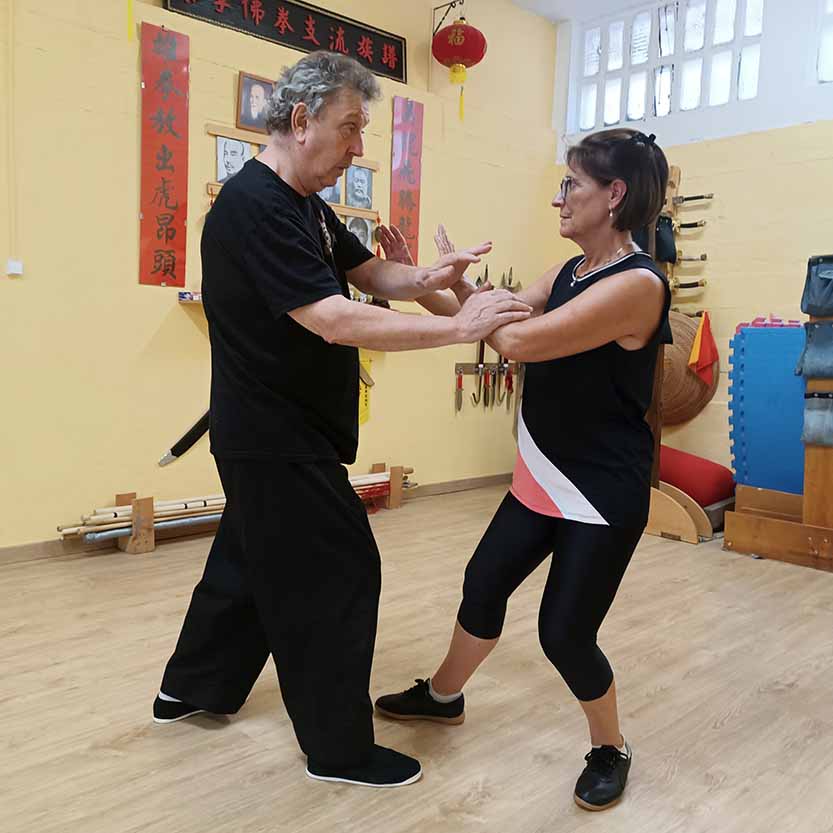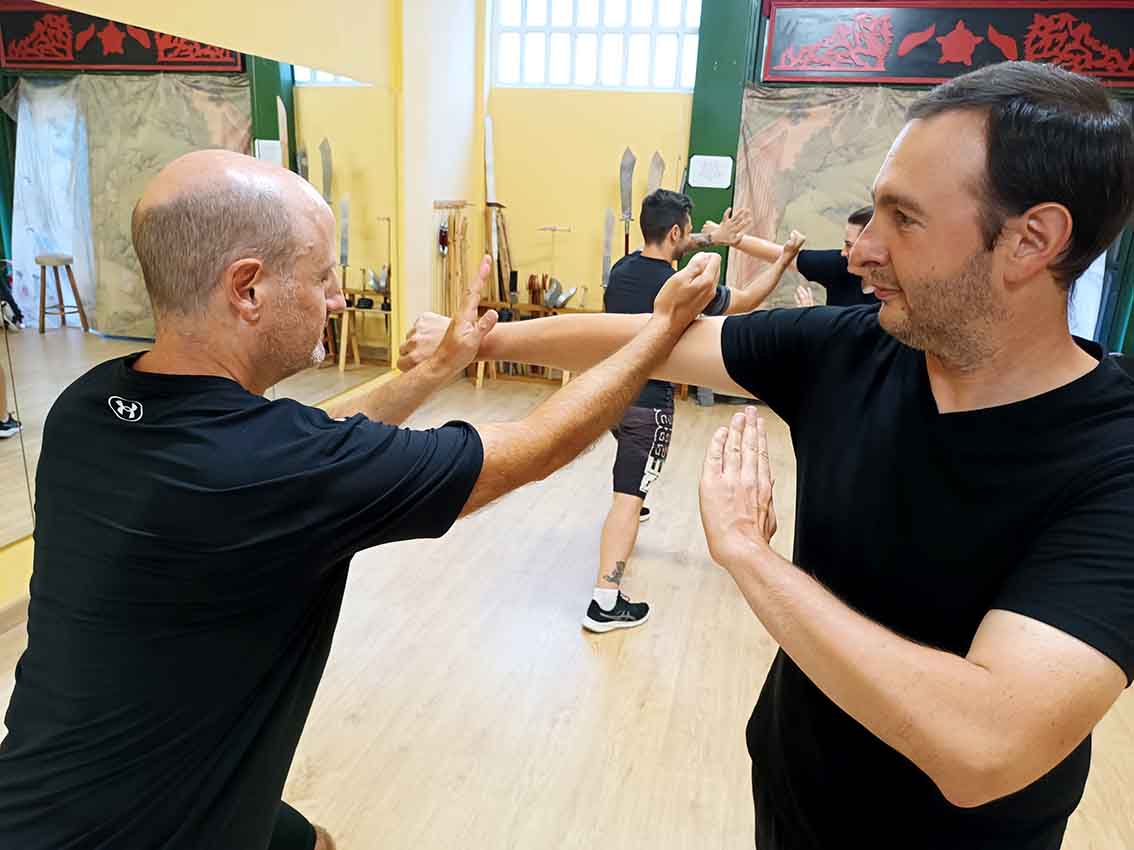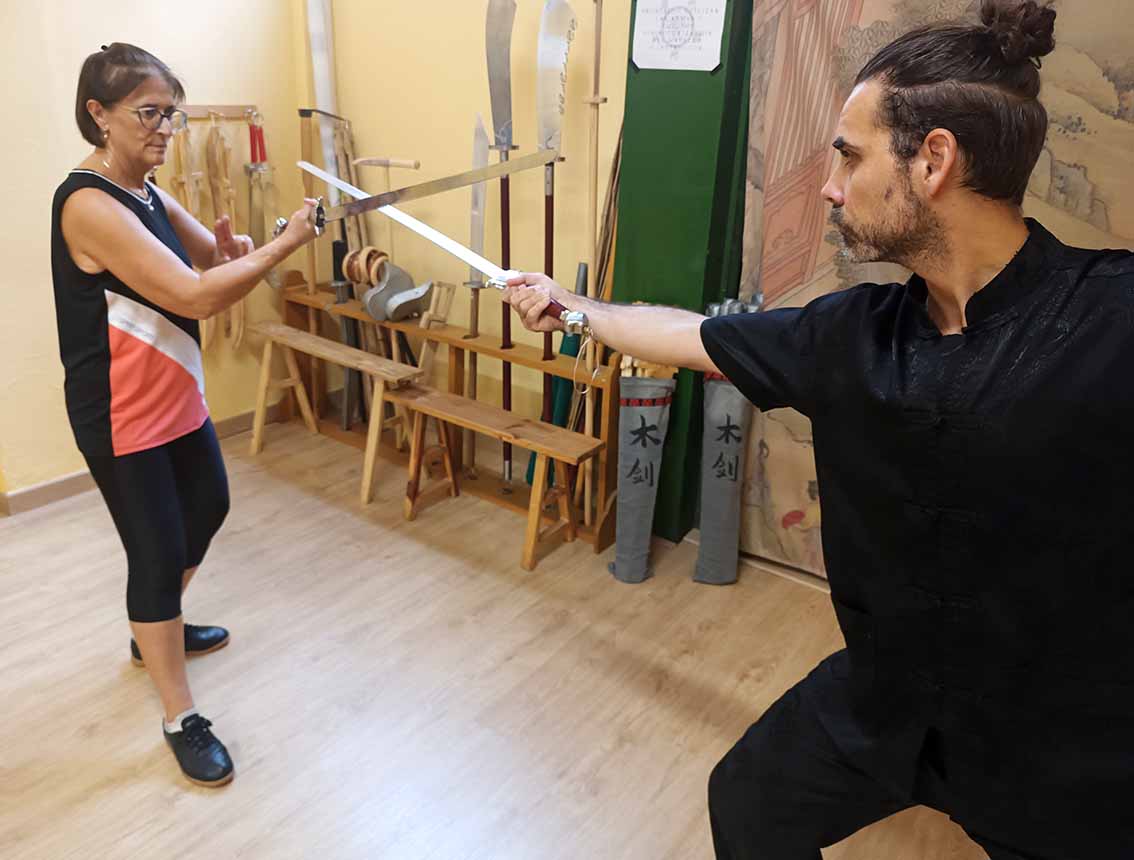Introduction
Tīng lì 聽力 refers, in the field of Chinese martial arts, to a type of skill related to the perception of the opponent's movements by means of touch, without depending on the sense of sight. All styles of Kung Fu, with more or less emphasis, make some use of it.
Some styles have their own tīng lì training systems, perhaps the best known being the chi sau 黐手 of Wing Chun 詠春 or the tuī shǒu 推手 of Tàijíquán 太極拳. However, just because a system does not have a specific method of training tīng lì does not mean that it does not make use of it.

Our Tàijíquán 太極拳 students practicing tuī shǒu 推手.
What is tīng lì
Tīng lì 聽力 or tīng jìn 聽勁 literally means the "power of listening", although this literal translation is not the most appropriate.
Jìn refers to a specific type of skill acquired through training, and although lì generally has other connotations, in this particular case the two terms are used interchangeably, although some systems may prefer the use of one over the other.
On the other hand, tīng, listening or hearing, does not refer in this case to the ability to hear, but to the ability to perceive movement or energy, mainly through touch. Note that here, when we talk about energy, we are not referring to a vital energy or qì 氣, nor to any kind of esoteric concept, but to the kinetic energy of a moving object, in this case the opponent's body. Tīng lì is not, therefore, an arcane ability cultivated by esoteric means, but something very real and palpable.

Whenever there is contact, there is use of tīng lì 聽力.
The importance of tīng lì in Chinese martial arts
This skill of perception is immensely useful in any martial art. In any confrontation, the sense of sight only predominates at the moment when both opponents are separated; at the moment of contact, sight takes a back seat, and touch becomes the most important sense. The speed at which our brain receives signals through touch is much greater than the speed with which it perceives visual signals.
Also, in a confrontation, we will not always be able to depend on vision. It may be night and dark, or we may have blurred vision because of sweat or blood on our eyes. In any case, when two bodies engage in combat, tact is crucial.
Through touch training we can correctly perceive the opponent's movement or force, and we can relate to it through an attitude of non-opposition.
This is also related to the ability of dǒng jìn 懂勁, the ability to "understand" what we perceive.
By acquiring these skills, we can make use of the opponent's strength or movement in our favour, so that we maximize our own efficiency, since we do not fight against the opponent's strength but adapt to it and, therefore, our energy consumption and effort are minimal.

The fields of application of tīng lì are so wide that they encompass the entire martial art, from striking and blocking to takedowns and throws, or qínná 擒拿 (joint control) techniques. What's more, this skill is essential in many of these areas, and it is impossible to reach a high level in them without having developed it.
But, in addition, tīng lì is also applied in a field in which there is not necessarily a "real" contact with the opponent: the fight with weapons. In Kung Fu, weapons become an extension of the practitioner's body, and the sense of "touch" extends to the weapon, making it possible to perceive the movement of the opponent's weapon through ours.

Students from our school practicing perception exercises with sword.
We have already named Wing Chun and Tàijíquán as styles that have specific exercises to develop tīng lì, but many other martial arts take advantage of this skill with great effectiveness. Not only the so-called "internal" styles, such as Bāguàzhǎng 八卦掌 and Xíngyìquán 形意拳, or Aikido and Judo among Japanese martial arts, but also other styles of Kung Fu considered as "hard styles", such as Hung Ga Kyun 洪家拳 or Choy Li Fut 蔡李佛, make use of this skill when applying their techniques in melee.
In the latter cases, tīng lì must be developed implicitly during each exercise in which there is contact with an opponent (tīng lì training, whether explicit or implicit, always requires a training partner; it is not a skill that can be developed individually).
Conclusion
In short, tīng lì is the "ability to perceive the opponent's movement by touch".
This skill is of utmost importance in the application of any martial art effectively and efficiently, and should be accompanied by other related skills, such as dǒng lì.
Some systems develop it specifically through exercises designed for this purpose, while others do it implicitly, but ultimately, any style of Kungfu must cultivate and pay attention to its development.
